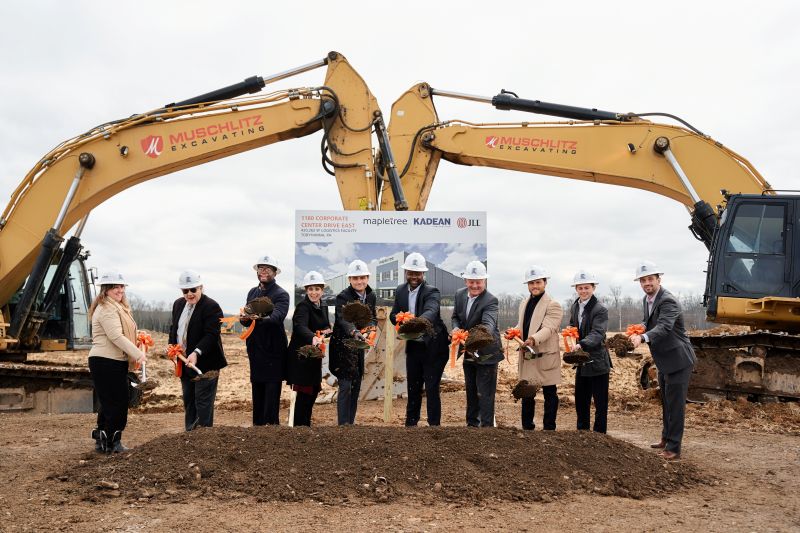21st Theater Sustainment Command Hosts Advanced Manufacturing Demonstration – army.mil

Report on U.S. Army Advanced Manufacturing Initiative in Europe
On November 13, 2025, the 21st Theater Sustainment Command (TSC) hosted a demonstration on advanced manufacturing at U.S. Army Garrison Bavaria in Grafenwöhr, Germany. The event, led by Maj. Gen. Michael Lalor, aimed to communicate a new strategy for integrating advanced manufacturing capabilities across the European theater. This initiative directly supports several United Nations Sustainable Development Goals (SDGs), particularly those focused on innovation, sustainable industry, and global partnerships.
Strategic Objectives and Alignment with Sustainable Development Goals (SDGs)
The primary goal of the initiative is to overcome the limitations of traditional, unresponsive supply chains and enhance military readiness. This strategy is intrinsically linked to building resilient infrastructure and promoting sustainable industrialization, as outlined in the SDGs.
Enhancing Resilient Infrastructure and Innovation (SDG 9)
The U.S. Army’s strategy focuses on creating a complementary network of advanced manufacturing capabilities to produce necessary components at the point of need. This approach modernizes logistical infrastructure and fosters innovation, directly contributing to SDG 9: Industry, Innovation and Infrastructure. Key objectives include:
- Developing a unified network to connect disparate manufacturing efforts across the theater.
- Solving critical capability gaps through Soldier-led innovation.
- Reducing reliance on long-lead-time supply chains, thereby increasing operational agility and resilience.
- Making a strategic investment in readiness that serves as a model for future operational logistics.
Promoting Responsible Consumption and Production (SDG 12)
Advanced manufacturing, particularly additive processes like 3D printing, inherently supports SDG 12: Responsible Consumption and Production. By fabricating parts on-demand and on-site, the initiative aims to:
- Substantially reduce material waste compared to traditional subtractive manufacturing methods.
- Minimize the carbon footprint associated with extensive global logistics and transportation.
- Create a supplemental system to fill supply chain gaps, ensuring efficient use of resources.
Fostering Global Partnerships for Sustainable Goals (SDG 17)
The strategy emphasizes collaboration as a cornerstone of its success, aligning with SDG 17: Partnerships for the Goals. The command is actively fostering multi-stakeholder relationships to achieve its objectives. This includes partnerships with:
- Allied and international military partners to create a unified effort.
- Industry leaders to leverage commercial innovation and expertise.
- Internal organizations such as the Army Combat Capabilities Development Command (DEVCOM) to advance technological capabilities.
Key Capabilities and Technological Demonstrations
The demonstration provided senior leaders with a tangible visualization of current and future advanced manufacturing capabilities designed to improve unit readiness and sustainability.
Current and Future Systems
Attendees were briefed on several key platforms that form the foundation of the theater’s advanced manufacturing ecosystem:
- Maintenance Activity Vilseck (MAV): A critical logistics and maintenance asset equipped with advanced technologies to ensure military equipment remains mission-ready.
- Metal Working and Machine Shop Set (MWMSS): A transportable or semi-mobile system that enables on-site fabrication of metal components, significantly reducing equipment downtime and promoting resource efficiency.
- Rapid Fabrication via Advanced Manufacturing on the Battlefield (R-FAB): A future capability highlighted as part of the Army’s forward-looking investment in battlefield innovation.
Future Outlook and Strategic Implementation
The forum underscored the U.S. Army’s commitment to modernizing its logistics and sustainment operations through innovation and collaboration, with a clear strategy for implementation.
Theater-Wide Data Repository
A significant future step is the establishment of a theater-wide repository for repair parts data, building on the efforts of the U.S. Army Materiel Command. This initiative will enhance collaboration and efficiency, ensuring that personnel have access to the necessary data for maintaining operational effectiveness. This knowledge-sharing platform is a key enabler for SDG 9 and SDG 17.
Conclusion
The 21st TSC is positioned to lead the modernization of logistics in the European theater. By integrating advanced manufacturing, the U.S. Army is not only enhancing its operational readiness but also adopting more sustainable and efficient practices. This strategic alignment with the Sustainable Development Goals ensures that the military remains agile and responsive in an increasingly complex global environment.
SDGs, Targets, and Indicators Analysis
1. Which SDGs are addressed or connected to the issues highlighted in the article?
-
SDG 9: Industry, Innovation and Infrastructure
This is the most prominent SDG in the article. The entire text focuses on the U.S. Army’s initiative to build a modern industrial and logistical infrastructure through innovation. The article discusses creating an “innovation center,” developing a “complementary network of advanced manufacturing capabilities,” and upgrading technological capabilities to solve supply chain issues. This directly relates to building resilient infrastructure, promoting industrialization, and fostering innovation.
-
SDG 17: Partnerships for the Goals
The article explicitly mentions the importance of collaboration. Maj. Gen. Lalor emphasizes fostering “relationships with allies, partners, and industry leaders.” The text states that the solution is not only “what the U.S. Army can do, but what we can do with our partners here internationally, and what we can do with our industry partners.” This highlights the multi-stakeholder approach central to SDG 17.
-
SDG 12: Responsible Consumption and Production
While not a primary focus, this SDG is implicitly connected through the nature of advanced manufacturing. The article describes a shift from traditional, often wasteful, supply chains to a system of producing parts “at the point of need.” This on-demand production model, such as 3D printing, can significantly reduce waste (Target 12.5) and improve resource efficiency (Target 12.2) compared to mass production and long-distance transportation of parts that may never be used.
2. What specific targets under those SDGs can be identified based on the article’s content?
-
SDG 9: Industry, Innovation and Infrastructure
- Target 9.4: By 2030, upgrade infrastructure and retrofit industries to make them sustainable, with increased resource-use efficiency and greater adoption of clean and environmentally sound technologies and industrial processes.
The article describes the U.S. Army upgrading its logistics infrastructure by adopting advanced manufacturing. This initiative aims to retrofit the traditional supply system to be more efficient and responsive, as seen in the goal to “target an unresponsive supply chain” and “reduce downtime.”
- Target 9.5: Enhance scientific research, upgrade the technological capabilities of industrial sectors… encouraging innovation.
The core of the article is about upgrading technological capabilities. It details the creation of an “innovation center for Soldiers,” the development of “materiel solutions,” and collaboration with research organizations like the “Army Combat Capabilities Development Command (DEVCOM)” to foster “Soldier-led innovation.”
- Target 9.4: By 2030, upgrade infrastructure and retrofit industries to make them sustainable, with increased resource-use efficiency and greater adoption of clean and environmentally sound technologies and industrial processes.
-
SDG 17: Partnerships for the Goals
- Target 17.16: Enhance the global partnership for sustainable development, complemented by multi-stakeholder partnerships that mobilize and share knowledge, expertise, technology and financial resources.
The article highlights the strategy of “fostering relationships with allies, partners, and industry leaders.” The demonstration event itself served as an “invaluable platform for sharing knowledge and fostering collaboration,” which directly aligns with the goal of sharing knowledge and expertise through partnerships.
- Target 17.16: Enhance the global partnership for sustainable development, complemented by multi-stakeholder partnerships that mobilize and share knowledge, expertise, technology and financial resources.
-
SDG 12: Responsible Consumption and Production
- Target 12.5: By 2030, substantially reduce waste generation through prevention, reduction, recycling and reuse.
The strategy to “produce at the point of need” and “fabricate parts on-site” implies a significant reduction in waste. This model prevents the overproduction of parts, reduces the need for large inventories, and minimizes waste associated with obsolete or unused stock common in traditional, long-lead-time supply chains.
- Target 12.5: By 2030, substantially reduce waste generation through prevention, reduction, recycling and reuse.
3. Are there any indicators mentioned or implied in the article that can be used to measure progress towards the identified targets?
-
For SDG 9 (Industry, Innovation and Infrastructure):
- Number of advanced manufacturing innovation cells established: The article mentions the 21st TSC is “aligning and coordinating other innovation cells and advanced manufacturing capabilities across the theater.” Tracking the number of these cells would measure the expansion of this new infrastructure.
- Development of a theater-wide parts repository: Progress can be measured by the establishment and population of the “Army wide repository for repair parts” mentioned in the article. The number of available digital part files would be a key metric.
- Reduction in equipment downtime: A key goal is to “significantly reducing downtime.” Measuring the average time equipment is non-operational due to a lack of parts would be a direct indicator of the initiative’s success.
-
For SDG 17 (Partnerships for the Goals):
- Number of formal partnerships with allies and industry: The article emphasizes collaboration with “allies, partners, and industry leaders.” The number of agreements or joint projects established would be a clear indicator of progress.
- Frequency of collaborative events: The demonstration is described as a “platform for sharing knowledge.” The number of similar forums, workshops, or joint training events held would indicate ongoing collaboration.
-
For SDG 12 (Responsible Consumption and Production):
- Percentage of repair parts produced on-demand vs. ordered from traditional supply chains: This would directly measure the shift in production patterns. The article’s goal is to use advanced manufacturing as a “supplemental or complementary system” to “fill some of our supply chain gaps.”
- Reduction in supply chain lead times: The article mentions the problem of “long lead times for parts.” A measurable reduction in the time from identifying a need to having a replacement part would indicate increased efficiency.
4. Summary Table of SDGs, Targets, and Indicators
| SDGs | Targets | Indicators (Implied from the Article) |
|---|---|---|
| SDG 9: Industry, Innovation and Infrastructure | 9.4: Upgrade infrastructure and retrofit industries for increased efficiency. |
|
| 9.5: Enhance research and upgrade technological capabilities to encourage innovation. |
|
|
| SDG 17: Partnerships for the Goals | 17.16: Enhance multi-stakeholder partnerships that share knowledge and technology. |
|
| SDG 12: Responsible Consumption and Production | 12.5: Substantially reduce waste generation through prevention and reduction. |
|
Source: army.mil
What is Your Reaction?
 Like
0
Like
0
 Dislike
0
Dislike
0
 Love
0
Love
0
 Funny
0
Funny
0
 Angry
0
Angry
0
 Sad
0
Sad
0
 Wow
0
Wow
0


















































.jpg.webp?itok=0ZsAnae9#)

























